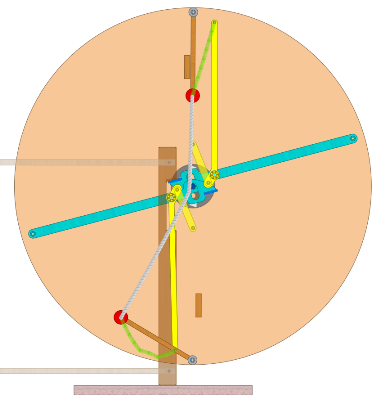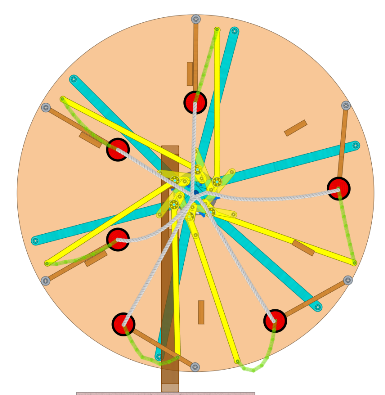
... further steps
in 2022
... two and two
the first wheels
MT18, wheel in wheel
MT18 with two arms
MT18 with three arms
Sketch of wheel 1
AP wheel in 3D
back to next steps
back to startpage
| back to german |

© 2022 by Alois Zimmermann | Kontakt | Impressum | Updates | Ausblick |
The first wheels
The pages „ ... two and two” describe the function and construction
of a simple Bessler wheel as it would be realised today.
Four of such systems with eight flying weights probably also represented
the basic structure of the last two wheels, which additionally had
a reversing mechanism.
Currently however I am of the opinion that the unbalance system of the first
wheels was even simpler.
To explain it, here a short excursion into Bessler’s concealment tactics
as far as I have understood them so far.
Bessler was an ingenious inventor and connoisseur of all kinds of scripts
and encryption techniques. Of course he wanted to keep his secret until
someone bought the invention from him, but he would have liked to tell
the world what fabulous thing he had discovered.
So he could not but to give hints in his writings, never coming near the
real solution.
Now it is good that there are people today who have time to spend years
on this subject, to decipher one clue after the other and possibly also
uncover the secret.
One of his tricks I have already found and revealed:
what you want to conceal you have to show openly - and only assign it a different function,
as in the case of the stamper mechanism.
Another trick is to write around it in a description, but leave out what is important.
Let me give MT24 and MT25 as an example.
MT24 has eight flying weights, MT25 only four. A picture with six weights is missing.
But that is exactly what would be correct.
The mechanics of the first two wheels are hidden behind the missing picture.
And if you want to speculate further on MT24: 2 + 4 = 6 - interesting!
For me, this strategy sums up Bessler’s verse on the last page of
Poëtische Apologie:
„Are you then still inconceivable
When I discover the art within/
So make the - - you subdued.”
The „- -” means:
the missing part, the not presented, the omission, the meaningful in between.
That which Bessler does not depict is the essential!
 |
So here is one system of two weights in red according to the sketch by MT24. A simple lever replaces the pulley from before, which saves weight and is easier to implement. The minimal pivot movement (green lever) is enlarged by the yellow linkage and used to swing out the upper flying weight. This pulls the lower weight inwards with the grey rope at the same time. Only by intervention of the stamper mechanism a perpetual movement can occur as written by Bessler in DT 21: „ ... but not only do they never reach an equilibrium or punktum quietis/ but seek it ceaselessly/ and in their admirable speed of flight/ in proportion to their own size as well as that of their shell, in addition they have to drive other burdens appli(cir)ed outside to Vorticis Verticalis.” |
The weights in the wheel therefore never can reach equilibrium and come to a standstill, if they are constantly stimulated anew by the stamper mechanism. The task for us is „only” to find the right proportions, i.e. the dimensions and weights, the lenght of the levers and their pivot points.
 |
|
Like Bessler, I was sometimes in despair. Did Bessler cheat after all?
Even then he would have been a genius. But he was too God-fearing for that.
Anyone who understands his writings knows that he did not lie. But how did he do it?
Now it is clear! The wheels worked as described and authenticated - and the principle is simple.
Even Prince Carl, Landgrave of Hesse, who was the only one allowed to see the mechanism,
said surprised:
„It’s astonishing that someone hasn’t discovered it before.”
And yet it took another 300 years and science still denies it.